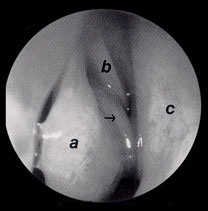最初应首先考虑三大嗅觉减退病因:前期病毒性感染、头部外伤和慢性鼻窦炎。每一个病因占到所有病因的15%-20%。[7]Deems DA, Doty RL, Settle RG, et al. Smell and taste disorders, a study of 750 patients from the University of Pennsylvania Smell and Taste Center. Arch Otolaryngol Head Neck Surg. 1991;117:519-528.http://www.ncbi.nlm.nih.gov/pubmed/2021470?tool=bestpractice.com[10]Seiden AM, Duncan HJ. The diagnosis of a conductive olfactory loss. Laryngoscope. 2001;111:9-14.http://www.ncbi.nlm.nih.gov/pubmed/11192906?tool=bestpractice.com其他不太常见的病因包括:暴露于有毒化学物质、放射或药物(例如,化疗药物、葡萄糖酸锌喷鼻剂);既往神经外科或颅面手术史;神经变性病;自身免疫性疾病;以及颅内肿瘤。由于遗传或年龄增长导致的嗅觉减退非常少见。不幸的是,绝大多数患者嗅觉减退的确切病因不得而知。
上呼吸道感染
大多数急性上呼吸道病毒感染 (URI) 都会伴随短暂性嗅觉减退。然而,少数患者嗅觉减退在发热及感冒症状消失后仍持续存在。这似乎是感觉性嗅觉减退,活检研究已经证实嗅裂存在嗅神经感受器及嗅上皮存在退行性变。[5]Jafek BW, Hartman L, Eller PM, et al. Postviral olfactory dysfunction. Am J Rhinol. 1990;4:91-100.患者可以是嗅觉缺失或嗅觉减退,其中多达66%有相关嗅觉倒错。年龄较大的患者更常见,男女比例为1:2。病毒感染导致的嗅觉减退不会波动,但是多达 66% 的患者可能在数年后会在一定程度上自发恢复。[12]Duncan HJ, Seiden AM. Long-term follow-up of olfactory loss secondary to head trauma and upper respiratory tract infection. Arch Otolaryngol Head Neck Surg. 1995;121:1183-1187.http://www.ncbi.nlm.nih.gov/pubmed/7546588?tool=bestpractice.com一项针对大量患者的回顾性研究发现,恢复发生率与发病年龄呈负相关,38.7% 的患者表现出临床显著改善。[13]Cavazzana A, Larsson M, Münch M, et al. Postinfectious olfactory loss: a retrospective study on 791 patients. Laryngoscope. 2017 May 29 [Epub ahead of print].http://www.ncbi.nlm.nih.gov/pubmed/28556265?tool=bestpractice.com
头部外伤
总体上,头部外伤患者中有接近5%的患者存在嗅觉减退,发生率随受伤严重程度增加而增加。[14]DiNardo LJ, Costanzo RM. Postraumatic olfactory loss. In: Seiden AM, ed. Taste and smell disorders. New York, NY: Thieme; 1997:79-87.[15]Collet S, Grulois V, Bertrand B, et al. Post-traumatic olfactory dysfunction: a cohort study and update. B-ENT. 2009;5:97-107.http://www.ncbi.nlm.nih.gov/pubmed/20084810?tool=bestpractice.com 相同的,伤后记忆缺失常伴随较高的伤后嗅觉缺失发生率。[16]Goodspeed RB, Gent JF, Catalanotto FA. Chemosensory dysfunction. Clinical evaluation results from a taste and smell clinic. Postgrad Med. 1987;81:251-257.http://www.ncbi.nlm.nih.gov/pubmed/3809040?tool=bestpractice.com伤后嗅觉减退多发生在额部或枕部外伤,与冲击性外力导致嗅神经丝在穿过筛板时的剥脱性损伤有关。这些患者多是嗅觉缺失,通常是20-50岁的男性(与头部外伤高发人群一致)。其他少数患者则可能由于额部或枕部外伤导致的脑震荡,并且会有所恢复,特别是伤后第一年。在头部外伤后嗅觉减退的患者中,接近66%的为嗅觉缺失,33%为嗅觉减退。[10]Seiden AM, Duncan HJ. The diagnosis of a conductive olfactory loss. Laryngoscope. 2001;111:9-14.http://www.ncbi.nlm.nih.gov/pubmed/11192906?tool=bestpractice.com
慢性鼻或鼻窦疾病
慢性鼻及鼻窦病变导致的嗅觉减退通常是由于堵塞鼻腔导致味素无法到达味觉感受器所致。这种嗅觉减退是传导性的而非感觉神经性的,尽管一些证据表明嗅神经上皮仍然有一些炎症改变存在。[17]Kern RC. Chronic sinusitis and anosmia: pathologic changes in the olfactory mucosa. Laryngoscope. 2000;110:1071-1077.http://www.ncbi.nlm.nih.gov/pubmed/10892672?tool=bestpractice.com[18]Konstantinidis I, Witt M, Kaidoglou K, et al. Olfactory mucosa in nasal polyposis: implications for FESS outcome. Rhinology. 2010;48:47-53.http://www.ncbi.nlm.nih.gov/pubmed/20502735?tool=bestpractice.com[19]Yee KK, Pribitkin EA, Cowart BJ, et al. Neuropathology of the olfactory mucosa in chronic rhinosinusitis. Am J Rhinol Allergy. 2010;24:110-120.http://www.ncbi.nlm.nih.gov/pubmed/20021743?tool=bestpractice.com堵塞可由单纯性鼻息肉造成,亦可继发于筛窦内局限性病变所致的水肿而非息肉。 [Figure caption and citation for the preceding image starts]: 应用硬性鼻内镜检查右侧鼻腔;可见息肉凸起于上鼻道(箭头),中鼻道正常;a=中鼻甲,b=上鼻甲,c=鼻中隔来自Dr Allen M.Seiden [Citation ends].一篇文献综述发现,慢性鼻-鼻窦炎患者嗅觉功能障碍的患病率接近 70%,具体取决于使用的检测方法。[20]Kohli P, Naik AN, Harruff EE, et al. The prevalence of olfactory dysfunction in chronic rhinosinusitis. Laryngoscope. 2017;127:309-20.http://www.ncbi.nlm.nih.gov/pubmed/27873345?tool=bestpractice.com不过,患者可能没有任何鼻塞或其他鼻腔症状,而仅仅表现为嗅觉减退。[10]Seiden AM, Duncan HJ. The diagnosis of a conductive olfactory loss. Laryngoscope. 2001;111:9-14.http://www.ncbi.nlm.nih.gov/pubmed/11192906?tool=bestpractice.com这使得诊断很困难,特别是需要跟病毒感染鉴别时。鉴别很重要,因为对慢性鼻-鼻窦炎进行有效治疗可以使嗅觉重新恢复。[21]Kohli P, Naik AN, Farhood Z, et al. Olfactory outcomes after endoscopic sinus surgery for chronic rhinosinusitis: a meta-analysis. Otolaryngol Head Neck Surg. 2016;155:936-48.http://www.ncbi.nlm.nih.gov/pubmed/27576679?tool=bestpractice.com
[Figure caption and citation for the preceding image starts]: 应用硬性鼻内镜检查右侧鼻腔;可见息肉凸起于上鼻道(箭头),中鼻道正常;a=中鼻甲,b=上鼻甲,c=鼻中隔来自Dr Allen M.Seiden [Citation ends].一篇文献综述发现,慢性鼻-鼻窦炎患者嗅觉功能障碍的患病率接近 70%,具体取决于使用的检测方法。[20]Kohli P, Naik AN, Harruff EE, et al. The prevalence of olfactory dysfunction in chronic rhinosinusitis. Laryngoscope. 2017;127:309-20.http://www.ncbi.nlm.nih.gov/pubmed/27873345?tool=bestpractice.com不过,患者可能没有任何鼻塞或其他鼻腔症状,而仅仅表现为嗅觉减退。[10]Seiden AM, Duncan HJ. The diagnosis of a conductive olfactory loss. Laryngoscope. 2001;111:9-14.http://www.ncbi.nlm.nih.gov/pubmed/11192906?tool=bestpractice.com这使得诊断很困难,特别是需要跟病毒感染鉴别时。鉴别很重要,因为对慢性鼻-鼻窦炎进行有效治疗可以使嗅觉重新恢复。[21]Kohli P, Naik AN, Farhood Z, et al. Olfactory outcomes after endoscopic sinus surgery for chronic rhinosinusitis: a meta-analysis. Otolaryngol Head Neck Surg. 2016;155:936-48.http://www.ncbi.nlm.nih.gov/pubmed/27576679?tool=bestpractice.com
暴露于有毒物质
暴露于各种工业或环境中有毒物质可以导致失嗅,虽然很多文献报道都缺乏依据。[22]Amoore JE. Effects of chemical exposure on olfaction in humans. In: Barrow CS, ed. Toxicology of the nasal passages. Washington. DC: Hemisphere Publishing; 1986;263-273.这类报道通常是短时暴露于过量有毒物质,而非长时间低剂量的暴露。多发生于工作场所,包括暴露于磷光,氯气,金属粉尘,有机溶剂,酸烟,石油蒸汽和一些房屋清洁剂。尽管发生率可能被低估了,大多数的报道中毒气暴露导致的嗅觉减退仍占到5%。[23]Upadhyay UD, Holbrook EH. Olfactory loss as a result of toxic exposure. Otolaryngol Clin N Amer. 2004;37:1185-1207.http://www.ncbi.nlm.nih.gov/pubmed/15563910?tool=bestpractice.com
一些药物也可以导致嗅觉缺失(比如安非他明、雌二醇、吩噻嗪、过长时间应用鼻减充血剂、利血平)。
嗅觉减退与应用非处方药葡萄糖酸锌鼻喷剂有关,后者可减轻上呼吸道感染或普通感冒的症状。[24]Jafek BW, Linschoten MR, Murrow BW. Anosmia after intranasal zinc gluconate use. Am J Rhinol. 2004;18:137-141.http://www.ncbi.nlm.nih.gov/pubmed/15283486?tool=bestpractice.com描述的这些病例中患者应用葡萄糖酸锌鼻喷雾剂后鼻腔立马有一种烧灼感,随后出现嗅觉减退。通常认为嗅觉减退是由于嗅神经上皮暴露于锌离子所致。[25]Alexander TH, Davidson TM. Intranasal zinc and anosmia: the zinc-induced anosmia syndrome. Laryngoscope. 2006;116:217-220.http://www.ncbi.nlm.nih.gov/pubmed/16467707?tool=bestpractice.com
化学治疗药物可以导致嗅觉和味觉丧失,头颈部放射治疗也会导致一过性嗅觉和味觉丧失。[26]Schiffman SS. Drugs influencing taste and smell perception. In: Getchell TV, Doty RL, Bartoshuk LM, et al, eds. Smell and taste in health and disease. New York, NY: Raven Press; 1991: 845-850.[27]Comeau TB, Epstein JB, Migas C. Taste and smell dysfunction in patients receiving chemotherapy: a review of current knowledge. Support Care Cancer. 2001;9:575-580.http://www.ncbi.nlm.nih.gov/pubmed/11762967?tool=bestpractice.com[28]Ophir D, Guterman A, Gross-Isseroff R. Changes in smell acuity induced by radiation exposure of the olfactory mucosa. Arch Otolaryngol Head Neck Surg. 1988;114:853-855.http://www.ncbi.nlm.nih.gov/pubmed/3390326?tool=bestpractice.com
术后
嗅觉减退常发生在前颅窝手术后,无论是前颅开颅入路还是颅面部入路。这是可以预料到的,因此患者很少因进一步的嗅觉测试而就诊。
嗅觉减退可以是鼻窦内镜手术直接损伤嗅裂或术后瘢痕堵塞嗅裂所致。但是这非常少见,发生率不到2%。[29]Hosemann W, Gode U, Wigand ME. Indications, technique, and results of endonasal endoscopic ethmoidectomy. Acta Otorhinolaryngol Belg. 1993;47:73-83.http://www.ncbi.nlm.nih.gov/pubmed/8470554?tool=bestpractice.com多数鼻窦术后持续性嗅觉减退是由于持续性鼻窦炎症所致。
神经退行性变
已经注意到嗅觉减退可以是一些神经退行性病变的早期症状,特别是阿尔茨海默症和帕金森病,尽管嗅觉减退是否客观存在或与痴呆有关尚不明确。[30]Kovacs T. Mechanisms of olfactory dysfunction in aging and neurodegenerative disorders. Ageing Res Rev. 2004;3:215-232.http://www.ncbi.nlm.nih.gov/pubmed/15177056?tool=bestpractice.com一些阿尔茨海默患者中,神经元纤维缠结和斑块确实波及脑内嗅觉相关区域,包括嗅球。伴有嗅觉减退的阿尔茨海默患者可能意识不到嗅觉缺失从而不去寻求医学帮助。[31]Devanand DP, Michaels-Marston KS, Liu X, et al. Olfactory deficits in patients with mild cognitive impairment predict Alzheimer's disease at follow-up. Am J Psychiatry. 2000;157:1399-1405.http://www.ncbi.nlm.nih.gov/pubmed/10964854?tool=bestpractice.com帕金森患者中嗅觉感知受损与快速神经退行性病变有关,步态失调更是如此。[32]Wilson RS, Arnold SE, Buchman AS, et al. Odor identification and progression of parkinsonian signs in older persons. Exp Aging Res. 2008;34:173-187.http://www.ncbi.nlm.nih.gov/pubmed/18568978?tool=bestpractice.com针对帕金森病患者的研究表明,嗅觉损伤至少有部分原因在于中枢神经系统衰退。[33]Iannilli E, Stephan L, Hummel T, et al. Olfactory impairment in Parkinson's disease is a consequence of central nervous system decline. J Neurol. 2017;264:1236-46.http://www.ncbi.nlm.nih.gov/pubmed/28550478?tool=bestpractice.com
自身免疫性疾病
嗅觉减退与一些自身免疫性疾病有关。多血管炎性肉芽肿(Wegener肉芽肿)和结节病可以表现在鼻子导致嗅裂炎症性阻塞,尽管结节病可以表现在神经结构异常。鼻窦疾病可以是Wegener肉芽肿的首发症状,随后出现肺肾相关症状。[34]Gottschlich S, Ambrosch P, Kramkowski D, et al. Head and neck manifestations of Wegener's granulomatosis. Rhinology. 2006;44:227-233.http://www.ncbi.nlm.nih.gov/pubmed/17216737?tool=bestpractice.com干燥综合征导致的嗅觉减退可能与干燥的鼻腔黏膜或淋巴细胞浸润及外分泌腺受损所致。[35]Getchell ML, Melbert TK. Olfactory mucus secretions. In: Getchell TV, Doty RL, Bartoshuk LM, et al, eds. Smell and taste in health and disease. New York, NY: Raven Press; 1991:83-95.多数患者可能除了嗅觉减退外还有其他症状。
鼻腔-鼻窦恶性肿瘤
无论良恶性鼻窦肿瘤都可以引起阻塞性嗅觉减退,但是患者常因为其他鼻腔症状像鼻塞或鼻出血等而就诊[7]Deems DA, Doty RL, Settle RG, et al. Smell and taste disorders, a study of 750 patients from the University of Pennsylvania Smell and Taste Center. Arch Otolaryngol Head Neck Surg. 1991;117:519-528.http://www.ncbi.nlm.nih.gov/pubmed/2021470?tool=bestpractice.com[10]Seiden AM, Duncan HJ. The diagnosis of a conductive olfactory loss. Laryngoscope. 2001;111:9-14.http://www.ncbi.nlm.nih.gov/pubmed/11192906?tool=bestpractice.com[16]Goodspeed RB, Gent JF, Catalanotto FA. Chemosensory dysfunction. Clinical evaluation results from a taste and smell clinic. Postgrad Med. 1987;81:251-257.http://www.ncbi.nlm.nih.gov/pubmed/3809040?tool=bestpractice.com
鼻腔神经胶质瘤是一种少见的恶性肿瘤,认为其发生于嗅神经上皮,虽然可以引起失嗅,但是患者通常表现为其他鼻腔症状。
前颅窝肿瘤像嗅沟脑膜瘤可以引起嗅觉减退。但是,这类患者一般因为头痛、意识缺陷、视野缺损或产生其他神经定位症状而就医。
遗传综合征
先天性失嗅占患者总数的3%左右。[10]Seiden AM, Duncan HJ. The diagnosis of a conductive olfactory loss. Laryngoscope. 2001;111:9-14.http://www.ncbi.nlm.nih.gov/pubmed/11192906?tool=bestpractice.com尽管一些研究较多的先天综合征与嗅觉减退有关,像Turner综合征和Kallmann综合征,但是绝大多数患者仅表现为失嗅。患者常回忆不起以前嗅觉相关记忆。[36]John H, Schmid C. Kallmann's syndrome: clues to clinical diagnosis. Int J Impot Res. 2000;12:121-123.http://www.ncbi.nlm.nih.gov/pubmed/11052640?tool=bestpractice.com失嗅的患者MRI可以表现为嗅球或嗅束发育不全,少数可以是额叶脑膨出,MRI亦可以表现为正常。[37]Hamilton BE, Weissman JL. Imaging of chemosensory loss. Otolaryngol Clin N Amer. 2004;37:1255-1280.http://www.ncbi.nlm.nih.gov/pubmed/15563913?tool=bestpractice.com
年龄
随着年龄增长可能出现嗅觉减退,但是70岁以前都不会特别明显。即使出现也常伴随着其他感觉减退,因此患者也能够接受这种缺陷而不去就医。另一方面,不简单地将老年人嗅觉减退归因于老年所致是很重要的。化学感受测试必须有年龄匹配对照。[4]Seiden AM. The initial assessment of patients with taste and smell disorders. In: Seiden AM, ed. Taste and smell disorders. New York, NY: Thieme; 1997:4-19.
 [Figure caption and citation for the preceding image starts]: 应用硬性鼻内镜检查右侧鼻腔;可见息肉凸起于上鼻道(箭头),中鼻道正常;a=中鼻甲,b=上鼻甲,c=鼻中隔来自Dr Allen M.Seiden [Citation ends].一篇文献综述发现,慢性鼻-鼻窦炎患者嗅觉功能障碍的患病率接近 70%,具体取决于使用的检测方法。[20]不过,患者可能没有任何鼻塞或其他鼻腔症状,而仅仅表现为嗅觉减退。[10]这使得诊断很困难,特别是需要跟病毒感染鉴别时。鉴别很重要,因为对慢性鼻-鼻窦炎进行有效治疗可以使嗅觉重新恢复。[21]
[Figure caption and citation for the preceding image starts]: 应用硬性鼻内镜检查右侧鼻腔;可见息肉凸起于上鼻道(箭头),中鼻道正常;a=中鼻甲,b=上鼻甲,c=鼻中隔来自Dr Allen M.Seiden [Citation ends].一篇文献综述发现,慢性鼻-鼻窦炎患者嗅觉功能障碍的患病率接近 70%,具体取决于使用的检测方法。[20]不过,患者可能没有任何鼻塞或其他鼻腔症状,而仅仅表现为嗅觉减退。[10]这使得诊断很困难,特别是需要跟病毒感染鉴别时。鉴别很重要,因为对慢性鼻-鼻窦炎进行有效治疗可以使嗅觉重新恢复。[21]